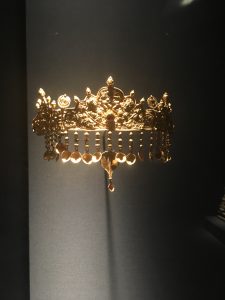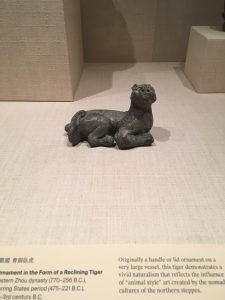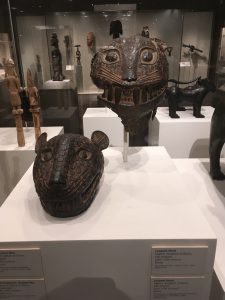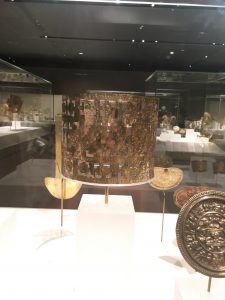Isabel Anguera
Professor San Miguel
Objects as History
16 November 2017
Comparing Cultures
Art can connect the world in fascinating ways. Cultures that are oceans or decades apart have historical and artistic connections that aren’t intentional or preconceived, and there are links that are shown through the objects that have been discovered throughout the years. It’s intriguing to see how cultures found in Africa can relate to ones from China through the incorporation of animals in their art, and how jewelry from both Indian and South American cultures can have similarities. These pieces show how different cultures dealt with the overall advancement of the world in terms of humanity and technology, and can even paint a picture of what living in the time period would have been like. The exhibits in The Met give a great idea of what each culture did with the resources they had available to them, and it’s easy to find similar ideas or concepts between cultures that one would not expect to find connections between.
The use of, and meaning behind animals in art has always been interesting to me, and has been prominent in both African and Chinese culture. In these cultures, specific animals have connections to personal traits and can be symbols of luck, wealth, power, and more. It is typical for these representations to link nature to man, and to show the culture in a more natural and universal way (The Nature). The piece that I chose from the African collection at The Met is an iron and brass sculpture of a leopard head from the Edo peoples (16th-19th century) in Nigeria (Figure). The leopard head, which is all black, is patterned, and looks modern and almost animated. The piece that I chose from the Ancient Chinese art collection is an “ornament in the form of a reclining tiger” made from bronze in the Eastern Zhou dynasty during the fourth or third centuries B.C. This piece was likely a part of a bigger vessel or sculpture (Ornament).
Even though the animals are not exactly the same (which could be due to geographic location), they are both a part of the feline family, and each one is tied to very strong traits. In Africa, a leopard is often connected to aggression, courage, and ferocity (Wayne), while in China tigers are seen as the most powerful creature in the world—the king of all animals (Tiger). What each animal represents is different in each culture, but both pieces use these strong ideas of connection between nature and humans in their art.
In terms of appearance, these two pieces are very similar—which is intriguing because of how far apart in time they were created. Both have patterns on them, which give them a more surreal and modern feel, and they are both made from metal. The African piece is a stand-alone sculpture of a leopard head, while the Chinese piece shows the tiger’s full body and is part of a bigger piece. One can tell that the African piece, which was made more recently, is cleaner and was likely made using more advanced or modernized techniques, while the tiger, although beautiful, looks slightly more organic and handmade (this could also be due to the amount of time that has passed since its creation). Both of these pieces are incredible and show both the talent of the artisans and importance of animals in each culture.
When it came to the Indian and Pre-Columbian America collections I was intrigued by the jewelry and accessories on display. What drew me to the piece I chose from India, the Diadem with Kinnaris, was the lack of jewelry that I saw within the rest of the collection, while what drew me to choose a Peruvian crown as my second piece was the fact that the Met’s collection of South American art seemed to include a huge amount of jewelry and gold in general.
The Indian diadem was made around the ninth and tenth centuries, and is made from gold. On it, as designs, are four ‘kinnaris,’ which are half bird, half woman entities, and in the middle rests a single gem—a garnet (Diadem).
The Peruvian crown, made between the twelfth and fifteenth centuries, is also made of gold, but was made for more ceremonial purposes (Crown). In terms of appearances, these two pieces do not share much in common other than the material and color. They are both meant to be worn to show wealth and, or power, and are both rather light looking. The Peruvian crown is very geometric and looks quite organic, while the Indian diadem is more elegant and tailored.
In terms of cultural connections, there was a huge difference in the amount of jewelry between the two collections. Jewelry in early India was often melted down so as to not pass on one’s karma to another person, which explains the lack of it and accessories that have survived since that time. In Pre-Columbian Andean culture, gold was plentiful, which allowed artisans to create jewelry, crowns, and accessories in heavy loads—this left a lot to be discovered, as it was less common to melt the pieces down. However, in the time that each of these pieces were made, they were made for wealthy people—being able to own one of these two pieces would have meant great power in both cultures. Whether it be for ceremonial reasons or as a symbol of respect or class, either of these pieces would get a message across.
Comparing objects from different cultures and time periods can open one’s eyes to how similar seemingly different cultures can really be. There are objects that exist in the world that can look related, such as the African leopard head and Chinese reclining tiger ornament, that were made hundreds of years and miles apart from each other. Although they could almost be from the same collection, it’s crazy to think that they were built by two different people who lived in different time periods and countries. In terms of the Indian diadem and Peruvian crown, it’s fascinating to see how similar objects can be created so differently. These are two objects that symbolize power—they are both accessories one wears on their head; they both display a similar message. However, they are so different looking from each other—it gives insight into how different two cultures can interpret big ideas like power, luxury and rule. It’s easy to separate each culture and see it as its own entity, but the truth is that these cultures often coexisted and experienced similar evolutions. In order to better understand the world, one must look at it as a whole rather than as separate parts.
References
“Crown | Chimú | The Met.” The Metropolitan Museum of Art. Accessed November 10,
https://metmuseum.org/art/collection/search/317796.
“Diadem with Kinnaris (Half-Bird, Half-Female Creatures) | India (Jammu & Kashmir,
ancient kingdom of Kashmir) | The Met.” The Metropolitan Museum of Art. Accessed November 10, 2017. https://www.metmuseum.org/art/collection/search/38435.
“Figure: Leopard Head | Edo peoples | The Met.” The Metropolitan Museum of Art.
Accessed November 10, 2017. https://www.metmuseum.org/art/collection/search/316526
“Ornament in the Form of a Reclining Tiger | China | Eastern Zhou dynasty, Warring
States period (475–221 B.C.) | The Met.” The Metropolitan Museum of Art. Accessed
November 9, 2017. https://www.metmuseum.org/art/collection/search/42179.
“The natural world: animals in african art.” Google Arts & Culture. Accessed November 9,
https://www.google.com/culturalinstitute/beta/usergallery/wQIyU3E-81EWLg.
“Tiger in Chinese Culture.” China Culture.org. Accessed November 9, 2017.
http://en.chinaculture.org/focus/focus/2010spring/2010-01/28/content_368022.htm.
Wayne. “The Symbolism of Animals in Africa.” Africa Imports African Business Blog.
May 02, 2016. Accessed November 10, 2017.
http://blog.africaimports.com/wordpress/2009/02/the-symbolism-of-animals-in-africa/.



